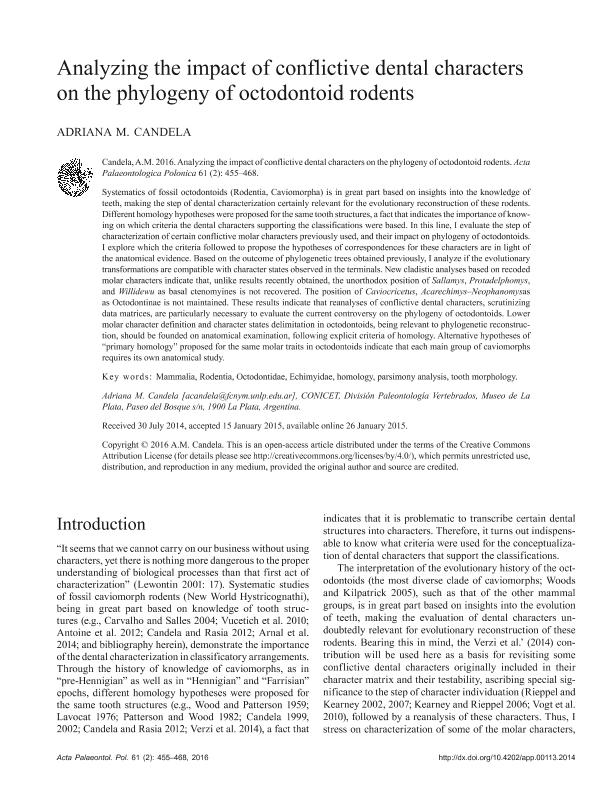Mostrar el registro sencillo del ítem
dc.contributor.author
Candela, Adriana Magdalena

dc.date.available
2018-08-07T19:51:38Z
dc.date.issued
2016-06
dc.identifier.citation
Candela, Adriana Magdalena; Analyzing the Impact of Conflictive Dental Characters on the Phylogeny of Octodontoid Rodents; Polish Academy of Sciences. Institute of Paleobiology; Acta Palaeontologica Polonica; 61; 2; 6-2016; 455-468
dc.identifier.issn
0567-7920
dc.identifier.uri
http://hdl.handle.net/11336/54488
dc.description.abstract
Systematics of fossil octodontoids (Rodentia, Caviomorpha) is in great part based on insights into the knowledge of teeth, making the step of dental characterization certainly relevant for the evolutionary reconstruction of these rodents. Different homology hypotheses were proposed for the same tooth structures, a fact that indicates the importance of knowing on which criteria the dental characters supporting the classifications were based. In this line, I evaluate the step of characterization of certain conflictive molar characters previously used, and their impact on phylogeny of octodontoids. I explore which the criteria followed to propose the hypotheses of correspondences for these characters are in light of the anatomical evidence. Based on the outcome of phylogenetic trees obtained previously, I analyze if the evolutionary transformations are compatible with character states observed in the terminals. New cladistic analyses based on recoded molar characters indicate that, unlike results recently obtained, the unorthodox position of Sallamys, Protadelphomys, and Willidewu as basal ctenomyines is not recovered. The position of Caviocricetus, Acarechimys-Neophanomysas as Octodontinae is not maintained. These results indicate that reanalyses of conflictive dental characters, scrutinizing data matrices, are particularly necessary to evaluate the current controversy on the phylogeny of octodontoids. Lower molar character definition and character states delimitation in octodontoids, being relevant to phylogenetic reconstruction, should be founded on anatomical examination, following explicit criteria of homology. Alternative hypotheses of "primary homology" proposed for the same molar traits in octodontoids indicate that each main group of caviomorphs requires its own anatomical study.
dc.format
application/pdf
dc.language.iso
eng
dc.publisher
Polish Academy of Sciences. Institute of Paleobiology

dc.rights
info:eu-repo/semantics/openAccess
dc.rights.uri
https://creativecommons.org/licenses/by-nc-sa/2.5/ar/
dc.subject
Echimyidae
dc.subject
Homology
dc.subject
Mammalia
dc.subject
Octodontidae
dc.subject
Parsimony Analysis
dc.subject
Rodentia
dc.subject
Tooth Morphology
dc.subject.classification
Otras Ciencias Biológicas

dc.subject.classification
Ciencias Biológicas

dc.subject.classification
CIENCIAS NATURALES Y EXACTAS

dc.title
Analyzing the Impact of Conflictive Dental Characters on the Phylogeny of Octodontoid Rodents
dc.type
info:eu-repo/semantics/article
dc.type
info:ar-repo/semantics/artículo
dc.type
info:eu-repo/semantics/publishedVersion
dc.date.updated
2018-08-06T17:40:36Z
dc.identifier.eissn
1732-2421
dc.journal.volume
61
dc.journal.number
2
dc.journal.pagination
455-468
dc.journal.pais
Polonia

dc.journal.ciudad
Varsovia
dc.description.fil
Fil: Candela, Adriana Magdalena. Universidad Nacional de La Plata. Facultad de Ciencias Naturales y Museo. División Paleontología Vertebrados; Argentina. Consejo Nacional de Investigaciones Científicas y Técnicas; Argentina
dc.journal.title
Acta Palaeontologica Polonica

dc.relation.alternativeid
info:eu-repo/semantics/altIdentifier/doi/http://dx.doi.org/10.4202/app.00113.2014
dc.relation.alternativeid
info:eu-repo/semantics/altIdentifier/url/http://www.bioone.org/doi/abs/10.4202/app.00113.2014
dc.relation.alternativeid
info:eu-repo/semantics/altIdentifier/url/http://www.app.pan.pl/article/item/app001132014.html
Archivos asociados
